Situational Leadership: Analysis of Employee Readiness and Conflict
VerifiedAdded on 2022/10/04
|5
|1120
|387
Report
AI Summary
This report delves into the application of situational leadership within a new branch office setting, focusing on the effective management of five employees with varying levels of readiness and motivation. The analysis, based on the Hersey and Blanchard model, assesses each employee's ability and willingness to perform, categorizing them into readiness levels. The report then prescribes appropriate leadership styles – telling, selling, and participating – to address the specific needs of each employee, aiming to mitigate conflicts and enhance performance. Furthermore, the report outlines a plan of action, suggesting interventions such as training, feedback mechanisms, and collaborative tools to foster employee development and commitment. The conclusion emphasizes the importance of adapting leadership styles to promote high morale and achieve organizational goals.
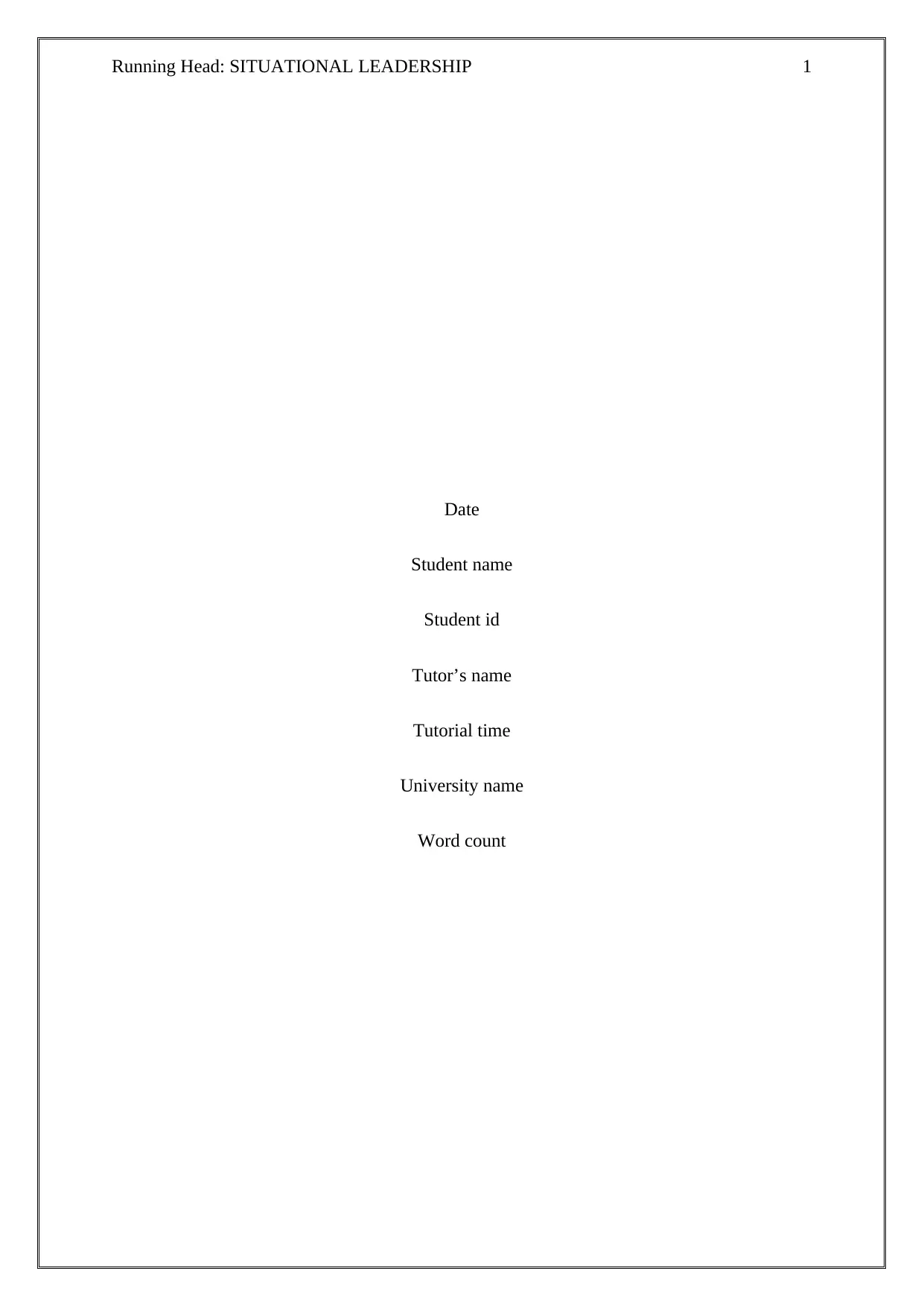
Running Head: SITUATIONAL LEADERSHIP 1
Date
Student name
Student id
Tutor’s name
Tutorial time
University name
Word count
Date
Student name
Student id
Tutor’s name
Tutorial time
University name
Word count
Paraphrase This Document
Need a fresh take? Get an instant paraphrase of this document with our AI Paraphraser
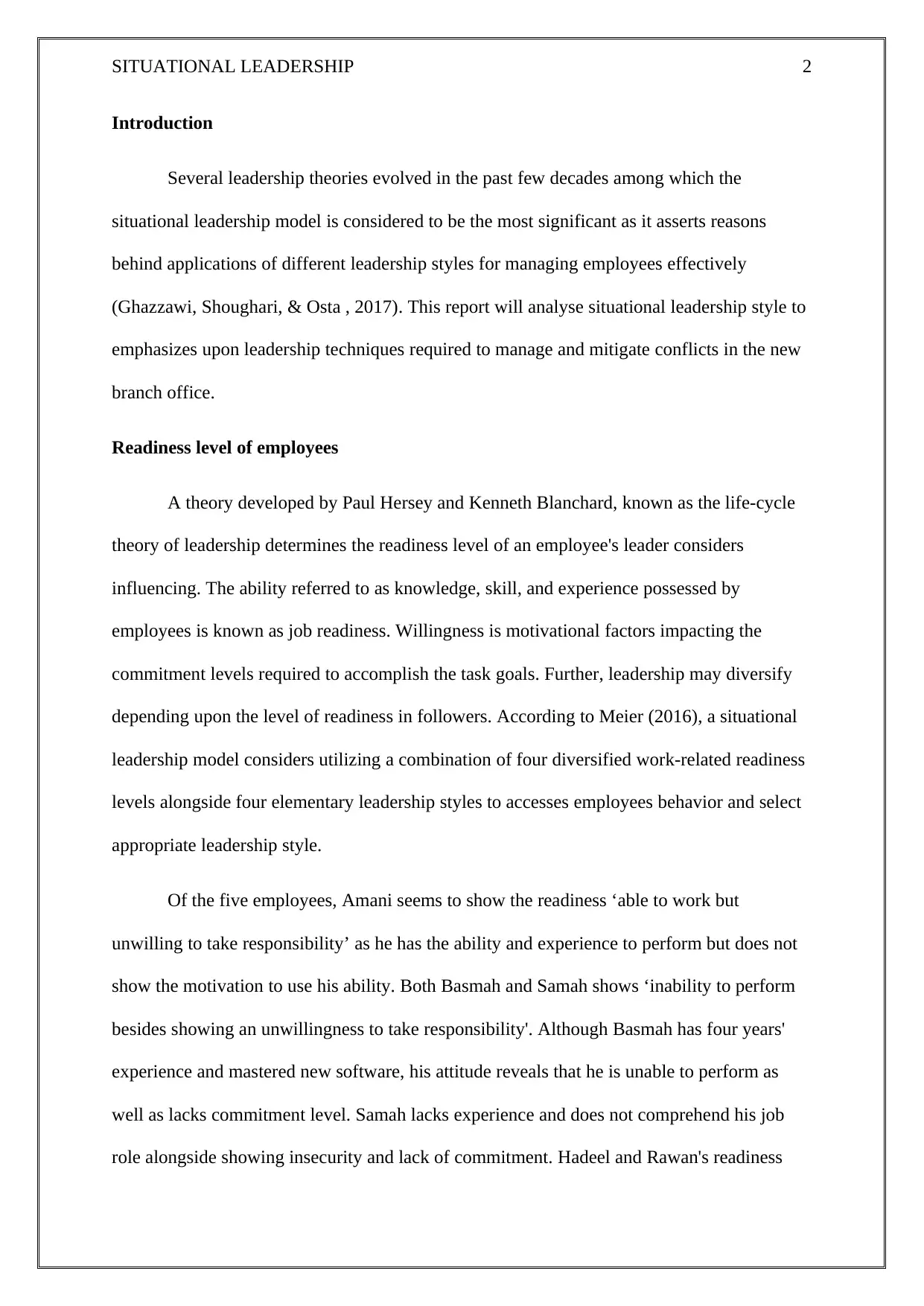
SITUATIONAL LEADERSHIP 2
Introduction
Several leadership theories evolved in the past few decades among which the
situational leadership model is considered to be the most significant as it asserts reasons
behind applications of different leadership styles for managing employees effectively
(Ghazzawi, Shoughari, & Osta , 2017). This report will analyse situational leadership style to
emphasizes upon leadership techniques required to manage and mitigate conflicts in the new
branch office.
Readiness level of employees
A theory developed by Paul Hersey and Kenneth Blanchard, known as the life-cycle
theory of leadership determines the readiness level of an employee's leader considers
influencing. The ability referred to as knowledge, skill, and experience possessed by
employees is known as job readiness. Willingness is motivational factors impacting the
commitment levels required to accomplish the task goals. Further, leadership may diversify
depending upon the level of readiness in followers. According to Meier (2016), a situational
leadership model considers utilizing a combination of four diversified work-related readiness
levels alongside four elementary leadership styles to accesses employees behavior and select
appropriate leadership style.
Of the five employees, Amani seems to show the readiness ‘able to work but
unwilling to take responsibility’ as he has the ability and experience to perform but does not
show the motivation to use his ability. Both Basmah and Samah shows ‘inability to perform
besides showing an unwillingness to take responsibility'. Although Basmah has four years'
experience and mastered new software, his attitude reveals that he is unable to perform as
well as lacks commitment level. Samah lacks experience and does not comprehend his job
role alongside showing insecurity and lack of commitment. Hadeel and Rawan's readiness
Introduction
Several leadership theories evolved in the past few decades among which the
situational leadership model is considered to be the most significant as it asserts reasons
behind applications of different leadership styles for managing employees effectively
(Ghazzawi, Shoughari, & Osta , 2017). This report will analyse situational leadership style to
emphasizes upon leadership techniques required to manage and mitigate conflicts in the new
branch office.
Readiness level of employees
A theory developed by Paul Hersey and Kenneth Blanchard, known as the life-cycle
theory of leadership determines the readiness level of an employee's leader considers
influencing. The ability referred to as knowledge, skill, and experience possessed by
employees is known as job readiness. Willingness is motivational factors impacting the
commitment levels required to accomplish the task goals. Further, leadership may diversify
depending upon the level of readiness in followers. According to Meier (2016), a situational
leadership model considers utilizing a combination of four diversified work-related readiness
levels alongside four elementary leadership styles to accesses employees behavior and select
appropriate leadership style.
Of the five employees, Amani seems to show the readiness ‘able to work but
unwilling to take responsibility’ as he has the ability and experience to perform but does not
show the motivation to use his ability. Both Basmah and Samah shows ‘inability to perform
besides showing an unwillingness to take responsibility'. Although Basmah has four years'
experience and mastered new software, his attitude reveals that he is unable to perform as
well as lacks commitment level. Samah lacks experience and does not comprehend his job
role alongside showing insecurity and lack of commitment. Hadeel and Rawan's readiness
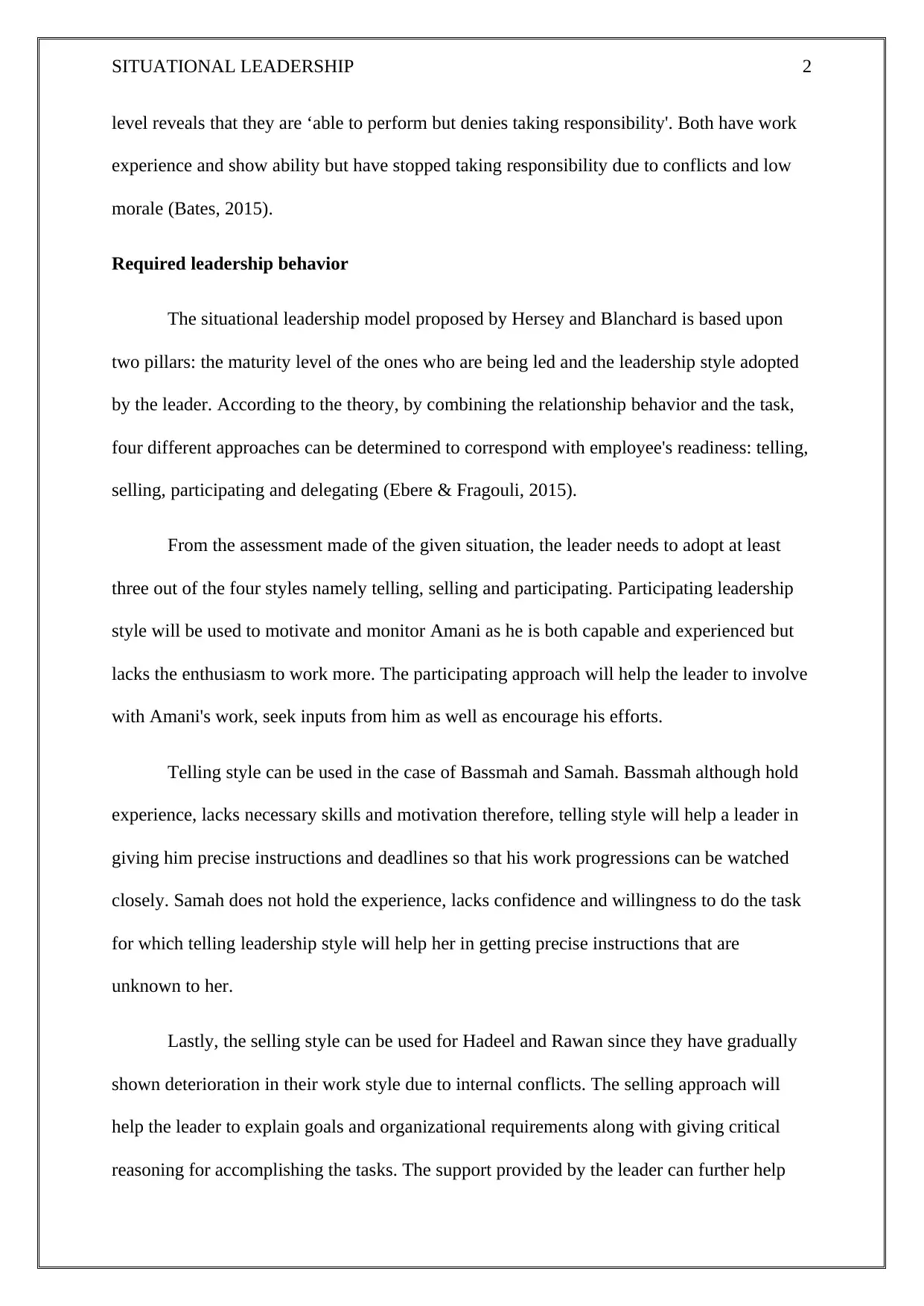
SITUATIONAL LEADERSHIP 2
level reveals that they are ‘able to perform but denies taking responsibility'. Both have work
experience and show ability but have stopped taking responsibility due to conflicts and low
morale (Bates, 2015).
Required leadership behavior
The situational leadership model proposed by Hersey and Blanchard is based upon
two pillars: the maturity level of the ones who are being led and the leadership style adopted
by the leader. According to the theory, by combining the relationship behavior and the task,
four different approaches can be determined to correspond with employee's readiness: telling,
selling, participating and delegating (Ebere & Fragouli, 2015).
From the assessment made of the given situation, the leader needs to adopt at least
three out of the four styles namely telling, selling and participating. Participating leadership
style will be used to motivate and monitor Amani as he is both capable and experienced but
lacks the enthusiasm to work more. The participating approach will help the leader to involve
with Amani's work, seek inputs from him as well as encourage his efforts.
Telling style can be used in the case of Bassmah and Samah. Bassmah although hold
experience, lacks necessary skills and motivation therefore, telling style will help a leader in
giving him precise instructions and deadlines so that his work progressions can be watched
closely. Samah does not hold the experience, lacks confidence and willingness to do the task
for which telling leadership style will help her in getting precise instructions that are
unknown to her.
Lastly, the selling style can be used for Hadeel and Rawan since they have gradually
shown deterioration in their work style due to internal conflicts. The selling approach will
help the leader to explain goals and organizational requirements along with giving critical
reasoning for accomplishing the tasks. The support provided by the leader can further help
level reveals that they are ‘able to perform but denies taking responsibility'. Both have work
experience and show ability but have stopped taking responsibility due to conflicts and low
morale (Bates, 2015).
Required leadership behavior
The situational leadership model proposed by Hersey and Blanchard is based upon
two pillars: the maturity level of the ones who are being led and the leadership style adopted
by the leader. According to the theory, by combining the relationship behavior and the task,
four different approaches can be determined to correspond with employee's readiness: telling,
selling, participating and delegating (Ebere & Fragouli, 2015).
From the assessment made of the given situation, the leader needs to adopt at least
three out of the four styles namely telling, selling and participating. Participating leadership
style will be used to motivate and monitor Amani as he is both capable and experienced but
lacks the enthusiasm to work more. The participating approach will help the leader to involve
with Amani's work, seek inputs from him as well as encourage his efforts.
Telling style can be used in the case of Bassmah and Samah. Bassmah although hold
experience, lacks necessary skills and motivation therefore, telling style will help a leader in
giving him precise instructions and deadlines so that his work progressions can be watched
closely. Samah does not hold the experience, lacks confidence and willingness to do the task
for which telling leadership style will help her in getting precise instructions that are
unknown to her.
Lastly, the selling style can be used for Hadeel and Rawan since they have gradually
shown deterioration in their work style due to internal conflicts. The selling approach will
help the leader to explain goals and organizational requirements along with giving critical
reasoning for accomplishing the tasks. The support provided by the leader can further help
⊘ This is a preview!⊘
Do you want full access?
Subscribe today to unlock all pages.

Trusted by 1+ million students worldwide
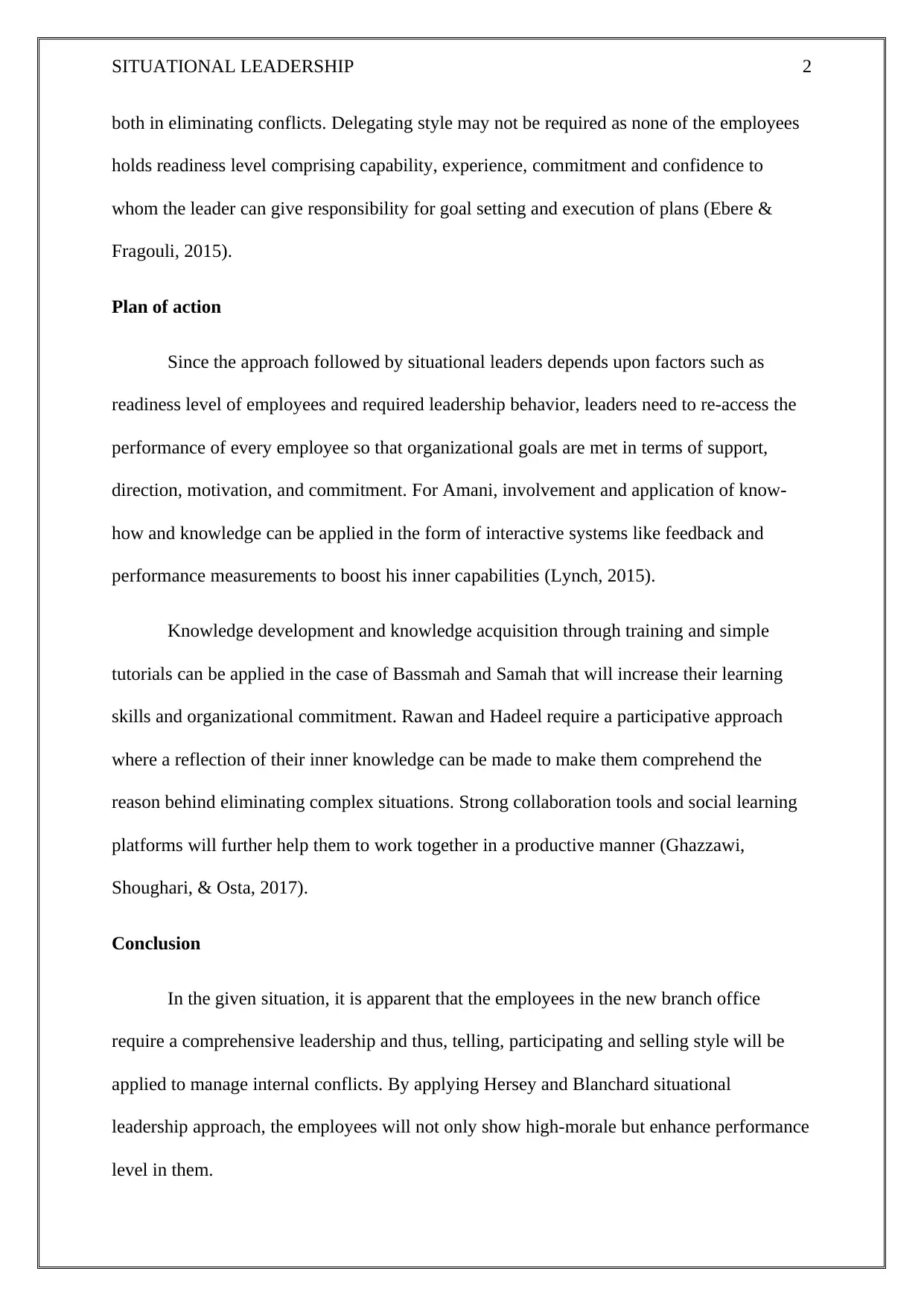
SITUATIONAL LEADERSHIP 2
both in eliminating conflicts. Delegating style may not be required as none of the employees
holds readiness level comprising capability, experience, commitment and confidence to
whom the leader can give responsibility for goal setting and execution of plans (Ebere &
Fragouli, 2015).
Plan of action
Since the approach followed by situational leaders depends upon factors such as
readiness level of employees and required leadership behavior, leaders need to re-access the
performance of every employee so that organizational goals are met in terms of support,
direction, motivation, and commitment. For Amani, involvement and application of know-
how and knowledge can be applied in the form of interactive systems like feedback and
performance measurements to boost his inner capabilities (Lynch, 2015).
Knowledge development and knowledge acquisition through training and simple
tutorials can be applied in the case of Bassmah and Samah that will increase their learning
skills and organizational commitment. Rawan and Hadeel require a participative approach
where a reflection of their inner knowledge can be made to make them comprehend the
reason behind eliminating complex situations. Strong collaboration tools and social learning
platforms will further help them to work together in a productive manner (Ghazzawi,
Shoughari, & Osta, 2017).
Conclusion
In the given situation, it is apparent that the employees in the new branch office
require a comprehensive leadership and thus, telling, participating and selling style will be
applied to manage internal conflicts. By applying Hersey and Blanchard situational
leadership approach, the employees will not only show high-morale but enhance performance
level in them.
both in eliminating conflicts. Delegating style may not be required as none of the employees
holds readiness level comprising capability, experience, commitment and confidence to
whom the leader can give responsibility for goal setting and execution of plans (Ebere &
Fragouli, 2015).
Plan of action
Since the approach followed by situational leaders depends upon factors such as
readiness level of employees and required leadership behavior, leaders need to re-access the
performance of every employee so that organizational goals are met in terms of support,
direction, motivation, and commitment. For Amani, involvement and application of know-
how and knowledge can be applied in the form of interactive systems like feedback and
performance measurements to boost his inner capabilities (Lynch, 2015).
Knowledge development and knowledge acquisition through training and simple
tutorials can be applied in the case of Bassmah and Samah that will increase their learning
skills and organizational commitment. Rawan and Hadeel require a participative approach
where a reflection of their inner knowledge can be made to make them comprehend the
reason behind eliminating complex situations. Strong collaboration tools and social learning
platforms will further help them to work together in a productive manner (Ghazzawi,
Shoughari, & Osta, 2017).
Conclusion
In the given situation, it is apparent that the employees in the new branch office
require a comprehensive leadership and thus, telling, participating and selling style will be
applied to manage internal conflicts. By applying Hersey and Blanchard situational
leadership approach, the employees will not only show high-morale but enhance performance
level in them.
Paraphrase This Document
Need a fresh take? Get an instant paraphrase of this document with our AI Paraphraser
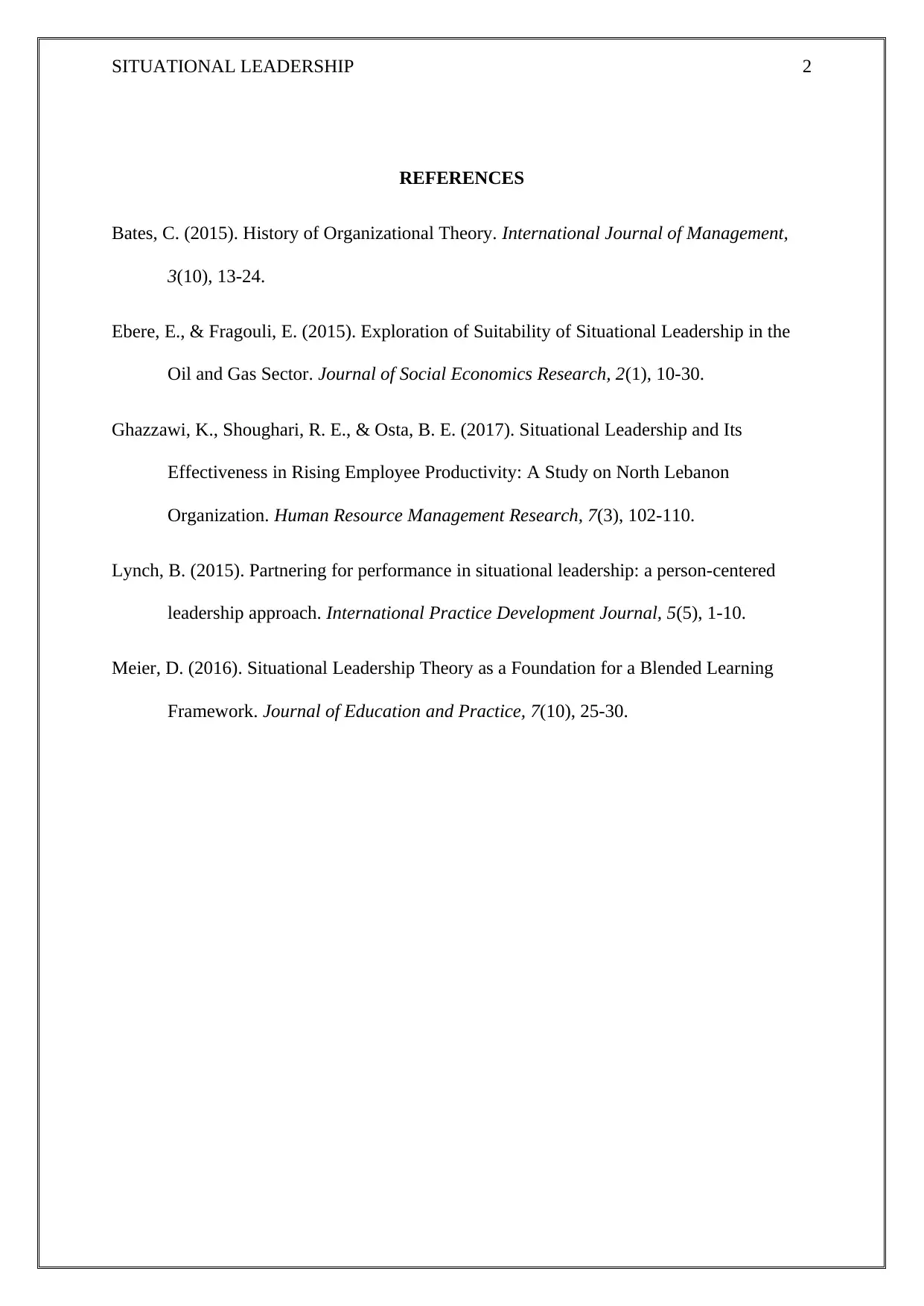
SITUATIONAL LEADERSHIP 2
REFERENCES
Bates, C. (2015). History of Organizational Theory. International Journal of Management,
3(10), 13-24.
Ebere, E., & Fragouli, E. (2015). Exploration of Suitability of Situational Leadership in the
Oil and Gas Sector. Journal of Social Economics Research, 2(1), 10-30.
Ghazzawi, K., Shoughari, R. E., & Osta, B. E. (2017). Situational Leadership and Its
Effectiveness in Rising Employee Productivity: A Study on North Lebanon
Organization. Human Resource Management Research, 7(3), 102-110.
Lynch, B. (2015). Partnering for performance in situational leadership: a person-centered
leadership approach. International Practice Development Journal, 5(5), 1-10.
Meier, D. (2016). Situational Leadership Theory as a Foundation for a Blended Learning
Framework. Journal of Education and Practice, 7(10), 25-30.
REFERENCES
Bates, C. (2015). History of Organizational Theory. International Journal of Management,
3(10), 13-24.
Ebere, E., & Fragouli, E. (2015). Exploration of Suitability of Situational Leadership in the
Oil and Gas Sector. Journal of Social Economics Research, 2(1), 10-30.
Ghazzawi, K., Shoughari, R. E., & Osta, B. E. (2017). Situational Leadership and Its
Effectiveness in Rising Employee Productivity: A Study on North Lebanon
Organization. Human Resource Management Research, 7(3), 102-110.
Lynch, B. (2015). Partnering for performance in situational leadership: a person-centered
leadership approach. International Practice Development Journal, 5(5), 1-10.
Meier, D. (2016). Situational Leadership Theory as a Foundation for a Blended Learning
Framework. Journal of Education and Practice, 7(10), 25-30.
1 out of 5
Related Documents
Your All-in-One AI-Powered Toolkit for Academic Success.
+13062052269
info@desklib.com
Available 24*7 on WhatsApp / Email
![[object Object]](/_next/static/media/star-bottom.7253800d.svg)
Unlock your academic potential
Copyright © 2020–2025 A2Z Services. All Rights Reserved. Developed and managed by ZUCOL.





